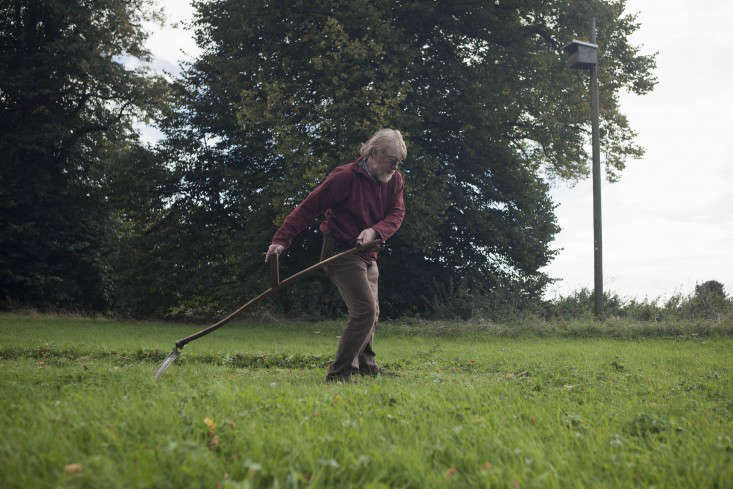

Photography by Jim Powell for Gardenista.
Photography by Jim Powell for Gardenista.
Once, lawns were cut with scythes and the results weren’t bad; Versailles for instance was cut that way.
Once, lawns were cut with scythes and the results weren’t bad; Versailles for instance was cut that way.
The author, Ian Miller, does say early on: “There’s no substitute for observing an experienced practitioner,” so, taking him at his word, we are off to East Anglia to observe.
The author, Ian Miller, does say early on: “There’s no substitute for observing an experienced practitioner,” so, taking him at his word, we are off to East Anglia to observe.
Lovells Hall in Norfolk, built in 1543 for Sir Thomas Lovell, Chancellor of the Exchequer to Henry VIII. The meadow on the other side of his driveway is a personal project.
Lovells Hall in Norfolk, built in 1543 for Sir Thomas Lovell, Chancellor of the Exchequer to Henry VIII. The meadow on the other side of his driveway is a personal project.
Watching and hearing Richard scythe is a powerful argument in its favor, each swing accompanied by a seductive sound of swooshing, as grass blades are quietly sliced. He is restoring it by adding plants like lady’s bedstraw and plantain as plugs or seeds, to areas of bare earth.
Watching and hearing Richard scythe is a powerful argument in its favor, each swing accompanied by a seductive sound of swooshing, as grass blades are quietly sliced. He is restoring it by adding plants like lady’s bedstraw and plantain as plugs or seeds, to areas of bare earth.
Because of mole hills and other disturbances, the ground is smoothed with a roller in spring, before scything begins. When the grass is the right length, new weed seedlings are easily lopped off by the swinging action of the scythe, which leaves the grass intact.
Because of mole hills and other disturbances, the ground is smoothed with a roller in spring, before scything begins. When the grass is the right length, new weed seedlings are easily lopped off by the swinging action of the scythe, which leaves the grass intact.
An Austrian scythe, lighter, smaller and far more popular than the English scythe. Scythes carry out more jobs (like weeding) than mowers.
An Austrian scythe, lighter, smaller and far more popular than the English scythe. Scythes carry out more jobs (like weeding) than mowers.
Before beginning, Richard sharpens his blade with a whetstone. As in sourdough bread making, the slow aspect of scything needs to be embraced otherwise it just won’t work.
Before beginning, Richard sharpens his blade with a whetstone. As in sourdough bread making, the slow aspect of scything needs to be embraced otherwise it just won’t work.
Scything is fantastic exercise for the core muscles and makes a good accompaniment to the Alexander Technique or Pilates. All of which is covered in the book, along with Mindfulness-Based Stress Reduction.
Scything is fantastic exercise for the core muscles and makes a good accompaniment to the Alexander Technique or Pilates. All of which is covered in the book, along with Mindfulness-Based Stress Reduction.
When scything, grass is cut in a semi-circle.
When scything, grass is cut in a semi-circle.
The very sharp and slightly scary blade used by Richard Brown.
The very sharp and slightly scary blade used by Richard Brown.
Richard’s rake, which he made himself from the wood of an ash tree.
Richard’s rake, which he made himself from the wood of an ash tree.
The fascinating The Scything Handbook begins with a quote from Leo Tolstoy, on scything with the peasants: “These were the blissful moments.” It is available now in the UK for £13.48, or, in the US, to pre-order on Amazon for $18.58.
The fascinating The Scything Handbook begins with a quote from Leo Tolstoy, on scything with the peasants: “These were the blissful moments.” It is available now in the UK for £13.48, or, in the US, to pre-order on Amazon for $18.58.


